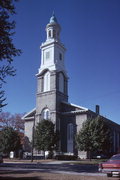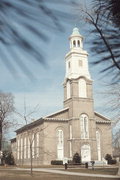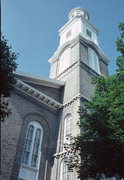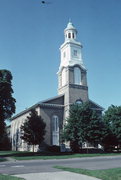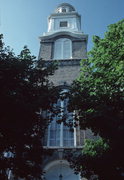| Additional Information: | A 'site file' exists for this property. It contains additional information such as correspondence, newspaper clippings, or historical information. It is a public record and may be viewed in person at the Wisconsin Historical Society, State Historic Preservation Office.
Damaged by fire 8/24/1998; the remains were razed and a new church constructed on the site.
The First Congregational Church of Beloit is significant architecturally as a major work of the mid-19th century Wisconsin architect Lucas Bradley of Racine. Bradley was a friend of Beloit College president--and First Congregational member--Aaron Lucius Chapman, and that relationship was instrumental in the awarding of the commission. The church, reflecting elements of both the Greek Revival and Romanesque Revival styles, was built of cream brick in 1859. A central square tower rises from the entry facade, through the pedimented gable and culminates in a wooden cupola added in 1894. Stone string courses and dentils ornament the cornice. The exterior facade is divided into bays marked by semi-circular arches into which are set rounded windows of tall and narrow proportion. On the side elevations, a gentle rhythm of bays proceeds from a blind recessed arch at the south to six windowed recessed arches to the north. Each arch holds tall pairs of rounded windows of triple hung sash separated by wooden panels from double hung rectangular pairs below.
Two entrances flank the central tower and lead directly into the auditorium; an entrance into the tower itself leads to a small vestibule. The rectangular auditorium is spanned by a plastered barrel vault. A gallery wraps around three sides of the hall, supported by twelve delicately carved bronzed cast-iron Corinthian columns. Directly above these are indetical columns which support the ceiling and a series of ribbed vaults which define each window bay. The windows rise unbroken behind the gallery. The bays are defined further by ribbing which crosses the barrel vault and terminates one other side with a console.
Bradley was apparently influenced by contemporary Greek Revival pattern books, which can be seen in several of his designs and which explains the evident influence of the revivalism on this church. Nevertheless, his buildings have proved to be among the most sensitive and accomplished pre-Civil War designs in Wisconsin, and the First Congregational Church is the finest extant 19th century church in the City of Beloit, and in all of Rock County.
Historically, the First Congregational Church is closely associated awith the early settlement of Beloit and the fonding of Beloit College. Visible for miles around, the spire locates the college campus, symbolizing its long ties with the intitution.
Founded in 1838 with 24 original members--many of whom came to Beloit with the New England Emigrating Company--the congregation's first permanent home was built in 1843 and briefly housed the first classes of Beloit College. In 1859, responding to the needs of an expanding membership, the congregation began construction of the present church, finally completing the cream brick structure in 1862. At the time of its completion, and for decades afterward, the auditorium of the First Congregational Church was the largest hall in the city, and thus an appropriate site for College activities as well as religious services. Indeed, on the day of dedication--July 6, 1862--the church was the site for Beloit College's baccalaureate service with President Chapin presiding.
The First Congregational Church, a Wisconsin Registered Landmark since 1965, was entered in the National Register of Historic Places in January, 1975. |
|---|

